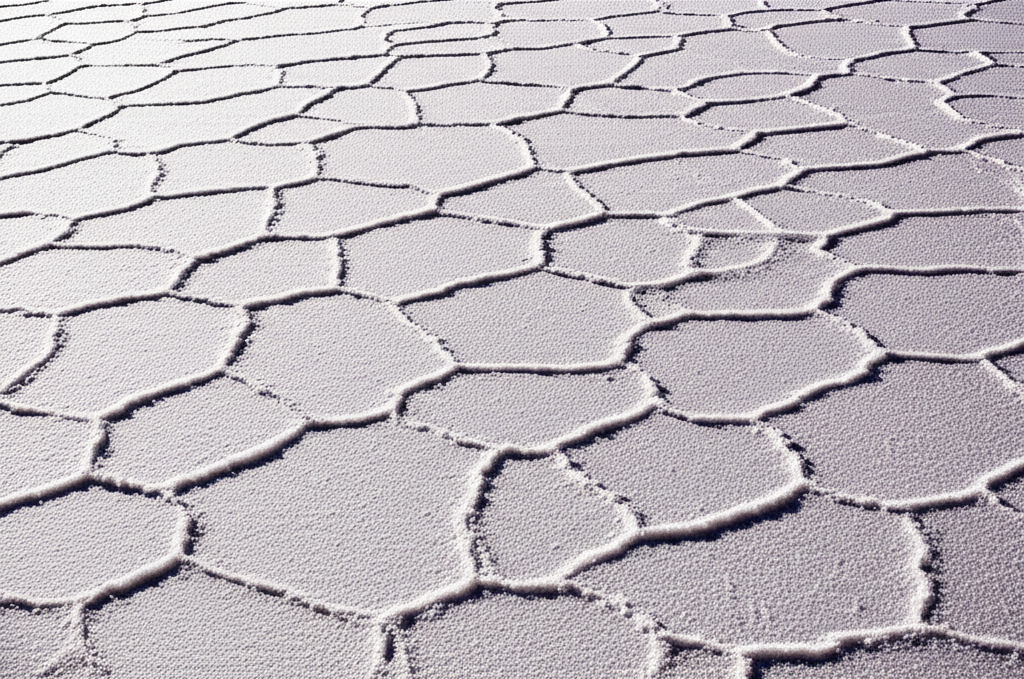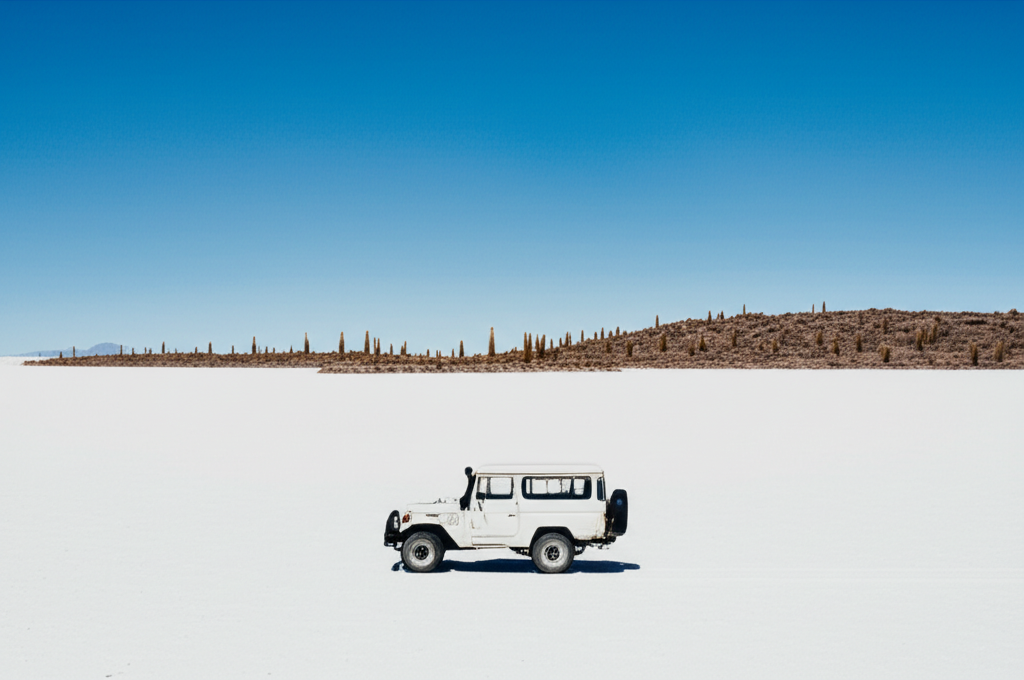Imagine a landscape so vast, so perfectly flat, it seems to melt into the sky itself. This is the surreal, otherworldly beauty of Salar de Uyuni, located in Southwest Bolivia. It is the world‘s largest salt flat, an immense, shimmering expanse that offers some of the most unique sights on Earth. Covering over 10,000 square kilometers, the Salar is famous for its stunning mirror effect during the wet season and its stark, geometric patterns when dry. This article will delve into its fascinating formation, incredible natural features, valuable resources, and provide essential tips for planning your visit to this unforgettable salt desert. Explore the wonders of Bolivia and its incredible natural treasures.
What is Salar de Uyuni? Location, Size, and Significance
Salar de Uyuni is situated in the Potosí department of southwestern Bolivia, high in the Andes mountains. It covers an astonishing 10,582 square kilometers (approximately 4,086 square miles). To grasp its scale, it’s larger than countries like Lebanon or Jamaica, and roughly the size of the state of Connecticut in the USA.
Sitting at an altitude of about 3,656 meters (11,995 feet) above sea level, its primary fame comes from the breathtaking mirror effect created by a thin layer of water during the wet season. This phenomenon turns the salt flat into the world’s largest natural mirror. The Salar is mainly composed of sodium chloride (common salt), but it also contains significant deposits of lithium, potassium, and magnesium.
The Geological Story: How Salar de Uyuni Was Formed
The formation of Salar de Uyuni is a remarkable tale stretching back millions of years, rooted in the geological history of the high-altitude Altiplano region.
From Ancient Lake to Salt Sea: The Legacy of Lake Minchin
During past ice ages, the Altiplano was home to vast prehistoric lakes. The most significant were Lake Minchin and later, Lake Tauca. These enormous bodies of water covered much of what is now the southwestern Bolivian highlands. As the climate changed and became drier, these lakes began to shrink dramatically over millennia.
The Role of Minerals and Evaporation
Surrounding volcanoes and mountain ranges contained rich mineral deposits, including various salts. As runoff flowed into the ancient lakes, it carried these minerals, accumulating them in the lakebeds. With the lakes receding under the intense sun and arid conditions of the high-altitude environment, the water evaporated at a high rate.
This intense evaporation left behind highly concentrated layers of mineral deposits. Over vast periods, these deposits built up, primarily consisting of salt. The final stages saw the lakes drying up almost entirely, leaving behind the immense, flat salt crust we see today, a direct legacy of these ancient bodies of water.
The Mystery of the Hexagonal Patterns
The dry surface of Salar de Uyuni is characterized by fascinating hexagonal patterns. These formations are a result of the salt crust drying and contracting. Moisture rises through capillary action from beneath the surface, carrying dissolved salts. As this water evaporates on the surface, the salt crystallizes.
The process of drying and contraction causes stresses in the crust. These stresses are most efficiently relieved by cracking in hexagonal shapes, which is a common pattern observed in drying materials like mud or paint, amplified here by the crystalline structure of salt. The size and prominence of the hexagons can vary depending on moisture levels and crystallization processes.
Unique Natural Phenomena and Ecosystems
Salar de Uyuni is not just a vast expanse; it’s a stage for unique natural phenomena and home to resilient life.
The World’s Largest Mirror: The Wet Season Phenomenon
During the wet season, typically from December to April, a thin layer of rainwater (often just a few centimeters deep) covers the surface of the Salar. This transforms the salt flat into an enormous, flawless mirror reflecting the sky. The horizon disappears, creating an astonishing illusion where the ground and sky merge seamlessly. This period offers unparalleled photographic opportunities, making you feel like you are walking among the clouds.
The Vast White Expanse: The Dry Season Landscape
From May to November, the Salar is largely dry. The surface is a blinding white crust etched with the characteristic hexagonal patterns. While you lose the mirror effect, the dry season offers easier accessibility and the chance to explore the vastness and geometric beauty of the salt desert under a clear blue sky. The sense of scale and emptiness is profound.

Isla Incahuasi and Other Rocky ‘Islands’
Rising abruptly from the flat salt sea are rocky outcrops that appear like islands. These are remnants of ancient volcanoes or peaks that were submerged by the prehistoric lakes. The most famous is Isla Incahuasi (Quechua for “Inca House”). This ‘island’ is covered in thousands of giant Cardon cacti (Echinopsis atacamensis), some standing over 10 meters tall and hundreds of years old. These islands support unique micro-ecosystems, offering a stark contrast to the surrounding salt. Other islands like Isla del Pescado (Fish Island) also exist.

Wildlife: The Pink Flamingos of the Altiplano
Despite the harsh environment, life finds a way. The hypersaline lagoons and wetlands around the fringes of Salar de Uyuni and the broader Altiplano region are home to several species of flamingos, including the Andean, Chilean, and James’s Flamingos. They are attracted by the algae and plankton in the salty water, which provide their food source and the carotenoids that give them their vibrant pink color. Flamingo sightings are often best during their breeding season.
Beyond Tourism: Resources and Local Life
Salar de Uyuni holds significant economic value and is intertwined with the lives of local communities.
The Lithium Treasure Trove
Salar de Uyuni is estimated to hold a substantial portion of the world’s known lithium reserves – potentially between 25% and 50%. Lithium is a critical component in rechargeable batteries, essential for electric vehicles, smartphones, and various portable electronic devices. Exploiting this resource has significant potential economic implications for Bolivia, though it also presents complex challenges related to infrastructure, technology, and environmental concerns.
Traditional Salt Harvesting
For centuries, local indigenous communities living near the Salar have practiced traditional salt harvesting. They gather the surface salt into mounds to dry before transporting it for sale or use. This age-old method provides a livelihood for some residents. The abundance of salt has also led to the unique construction of buildings, including hotels, made almost entirely from salt blocks extracted from the Salar.
Indigenous Communities and Culture
The region surrounding Salar de Uyuni is home to indigenous communities whose way of life has been shaped by the demanding high-altitude desert environment. These communities often maintain strong connections to the land, relying on traditional farming (like quinoa) and llama herding. Their culture reflects resilience and adaptation to a challenging landscape that is both a source of resources and a natural wonder.
Planning Your Adventure: Tips for Visiting Salar de Uyuni
| Feature | Wet Season (Dec-Apr) | Dry Season (May-Nov) |
|---|---|---|
| Main Attraction | World’s Largest Mirror Effect | Vast White Expanse, Hexagonal Patterns |
| Accessibility | Can be limited or require detours due to water | Generally easier to traverse by vehicle |
| Temperature | Warmer days, but still cold nights/early mornings | Colder, especially nights; strong sun by day |
| Photography | Incredible reflections, challenging glare | Stark beauty, clear patterns, less glare |
| Flamingos | Often present in surrounding lagoons | Present, but may be less concentrated |
Decide based on whether the mirror effect or easier travel and dry landscape are your priority.
Getting There: Gateways to the Salt Flat
The primary gateway is Uyuni town in Bolivia. You can reach Uyuni by flying from major Bolivian cities like La Paz, Santa Cruz, or Sucre. There are also overnight buses or a less frequent train service. Alternatively, some tours start from Tupiza, Bolivia, or San Pedro de Atacama (via Calama) in Chile. Uyuni town is the most common starting point for tours directly onto the Salar.
Selecting a Tour: Options and What to Expect
Tours are essential as navigating the Salar is impossible without an experienced guide and vehicle. Common options include 1-day tours covering the central Salar sights (train cemetery, salt hotels, Isla Incahuasi) or 3-day/2-night tours that extend into the surrounding desert landscapes, colored lagoons, geysers, and hot springs. Book with reputable operators, either in advance or upon arrival in Uyuni. Tours typically include transport (usually 4×4 vehicles), a guide, and meals. Longer tours include basic overnight accommodation (often in simple hostels).
Essential Packing Guide
The environment is harsh with extreme sun, cold, and lack of facilities. Pack smart:
- Sun protection: High SPF sunscreen, wide-brimmed hat, sunglasses (essential for glare).
- Layers of clothing: Temperatures fluctuate wildly; thermal layers, fleece, warm jacket, hat, gloves for cold nights.
- Comfortable, sturdy walking shoes or boots.
- Plenty of water and snacks.
- Camera, extra batteries, power bank – you’ll take many photos.
- Basic personal first-aid kit, including medication for headaches or stomach issues.
Altitude Sickness and Safety Tips
Uyuni and the surrounding Altiplano are at very high altitude. Altitude sickness (soroche) is a risk. Acclimatize for a day or two in a high-altitude city like La Paz or Uyuni before your tour. Drink plenty of water, avoid alcohol and heavy meals initially, and consider coca tea or altitude medication if advised by a doctor. Always stay with your guide and vehicle; getting lost in the vast, featureless expanse is extremely dangerous. Facilities are scarce, and communication is limited in remote areas. Stay hydrated throughout your trip.
Conclusion
Salar de Uyuni is a place of unparalleled natural wonder. From its incredible size – the world’s largest salt flat – to its fascinating geological origins from ancient lakes, it offers a landscape like no other. The stunning mirror effect, the geometric patterns of the dry season, the unique cactus islands, and the presence of pink flamingos create a visually spectacular experience. Beyond its beauty, the Salar holds valuable lithium resources and is tied to the traditional lives of local communities. Visiting Salar de Uyuni is an adventure that requires preparation but rewards you with unforgettable sights and a deep appreciation for the extraordinary forces that shape our planet. It is truly a must-visit destination for any traveler seeking unique natural beauty and a profound sense of scale.
FAQ about Salar de Uyuni
Q: What is the best time to see the mirror effect?
A: The mirror effect is typically best during the wet season, from December to April, when a thin layer of water covers the salt surface.
Q: How was the Salar de Uyuni formed?
A: It formed from the evaporation of vast prehistoric lakes (like Lake Minchin) that once covered the high-altitude Altiplano region, leaving behind thick salt deposits.
Q: Are there hotels on the salt flat?
A: Yes, there are hotels built almost entirely from salt blocks located near the edge of the Salar.
Q: What is Isla Incahuasi famous for?
A: Isla Incahuasi is known for being a rocky ‘island’ in the middle of the salt flat covered in giant, ancient Cardon cacti.
Q: Is it safe to visit Salar de Uyuni?
A: With a reputable tour operator and by taking precautions for altitude sickness and following your guide’s instructions, it is generally safe. The main risks are altitude, getting lost, or vehicle issues in remote areas.

